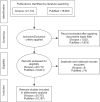The evolution and mapping trends of mobile health (m-Health): a bibliometric analysis (1997-2023)
- PMID: 39114458
- PMCID: PMC11304092
- DOI: 10.21037/mhealth-23-20
The evolution and mapping trends of mobile health (m-Health): a bibliometric analysis (1997-2023)
Abstract
Background: Mobile health (m-Health) is widely acknowledged as a pivotal domain for improving global healthcare and driving its digital health transformation. Despite the vast amount of literature published in recent years, bibliometric studies on m-Health remain limited in scope and coverage. This study presents a comprehensive review of m-Health literature extracted from Scopus and PubMed databases, spanning the period from 1997 to 2023, including publications during the coronavirus disease 2019 (COVID-19) pandemic.
Methods: The combined Scopus and PubMed databases were used in this study. The search formula for the literature retrieval used the most appropriate and relevant keywords to m-Health. The bibliometric data importation, extraction and analysis of authors, titles, publication date, publication place, publisher, volume number, issue number, citation count, document type, author keywords, affiliation were all carried out using the 'Biblioshiny', 'EndNote X9®', 'Microsoft Excel®' and 'Microsoft Access®' software tools. Duplicate records were manually identified and removed. Visualization maps illustrating the recurrent keywords, collaboration patterns, and prolific publishing countries were generated using 'VOSviewer®'.
Results: A total of 37,470 (20,703 from Scopus and 16,767 from PubMed) publications were selected for the literature analysis. The results provided the definitive literature evidence on the origin of the concept of m-Health in 2003. Significant increase in the publications followed the global surge of smart phones usage in 2007, and the emergence of m-Health applications (Apps) and their global markets and ecosystems. The number of the publications peaked between 2013 and 2022 with most citations in 2022. There was noticeable spike in m-Health literature during the COVID-19 pandemic. The results also showed that most of the highly cited publications, leading institutions, and most prolific authors were predominantly from the developed countries. The USA has the highest number of publications followed by the UK, Australia, Germany, Canada and China, with most of the prolific authors originating from these countries.
Conclusions: In conclusion, while there has been a remarkable increase in global m-Health publications since 2003, most of the impactful literature and publications in this area originated from selected countries in the developed world. The study indicates a significant disparity between the published literature from developed compared to the developing countries. Addressing this disparity, further bibliographical studies are required to address these and other literature gaps.
Keywords: Mobile health (m-Health); bibliometric; digital health; telemedicine.
2024 mHealth. All rights reserved.
Conflict of interest statement
Conflicts of Interest: All authors have completed the ICMJE uniform disclosure form (available at https://mhealth.amegroups.com/article/view/10.21037/mhealth-23-20/coif). R.S.H.I. serves as an unpaid editorial board member of mHealth from March 2023 to February 2025. The other authors have no conflicts of interest to declare.
Figures








Similar articles
-
Global research trends in MERS-CoV: A comprehensive bibliometric analysis from 2012 to 2021.Front Public Health. 2022 Aug 4;10:933333. doi: 10.3389/fpubh.2022.933333. eCollection 2022. Front Public Health. 2022. PMID: 35991022 Free PMC article.
-
Medical magnetic resonance imaging publications in Arab countries: A 25-year bibliometric analysis.Heliyon. 2024 Mar 26;10(7):e28512. doi: 10.1016/j.heliyon.2024.e28512. eCollection 2024 Apr 15. Heliyon. 2024. PMID: 38590895 Free PMC article.
-
Folic acid supplementation and malaria susceptibility and severity among people taking antifolate antimalarial drugs in endemic areas.Cochrane Database Syst Rev. 2022 Feb 1;2(2022):CD014217. doi: 10.1002/14651858.CD014217. Cochrane Database Syst Rev. 2022. PMID: 36321557 Free PMC article.
-
Research trends in the field of the gut-brain interaction: Functional dyspepsia in the spotlight - An integrated bibliometric and science mapping approach.Front Neurosci. 2023 Mar 8;17:1109510. doi: 10.3389/fnins.2023.1109510. eCollection 2023. Front Neurosci. 2023. PMID: 36968499 Free PMC article. Review.
-
Bibliometric study of immunotherapy for hepatocellular carcinoma.Front Immunol. 2023 Aug 4;14:1210802. doi: 10.3389/fimmu.2023.1210802. eCollection 2023. Front Immunol. 2023. PMID: 37600802 Free PMC article. Review.
References
-
- Istepanian RSH, Woodward B. m-Health: Fundamentals and Applications. Hoboken, NJ: John Wiley & Sons, Inc.; 2017:424.
-
- Malvey D, Slovensky DJ. mHealth. Boston, MA: Springer US; 2014. Available online: https://link.springer.com/10.1007/978-1-4899-7457-0 - DOI
LinkOut - more resources
Full Text Sources
